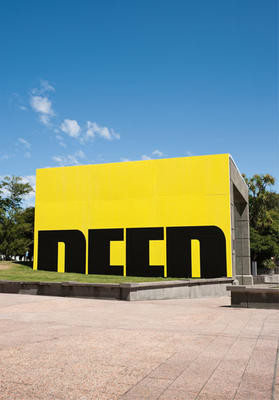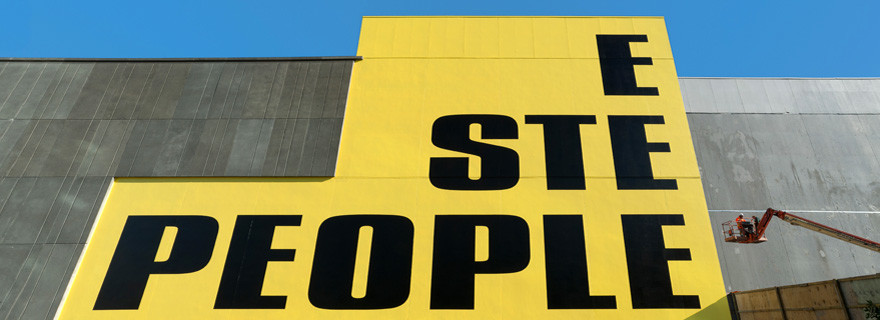B.
Steeple people
Behind the scenes
Having just come back to Christchurch after seven months overseas, I've been clocking up plenty of where's-it-gone and what-went-there and where-the-hell-am-I moments.
As I discovered on a recent lunch-time walk, some of the most disorienting new gaps are right behind the Gallery, where many of the buildings that once stood between us and the river are now gone.
Looking on the bright (yellow) side, however, this has opened up some grand new views of Kay Rosen's magnificent wall painting Here are the people and there is the steeple – a mural which uses language to explore how buildings are made and what they're made of.
You can read the rest of the interview here. And for further evidence that art can be both sharply political and sublimely playful, don't miss Kay's recent work about the situation in Afghanistan, Between a rock and a hard place.

Kay Rosen Here Are the People and There Is the Steeple 2012. Acrylic paint on wall, Christchurch Public Art Gallery, Christchurch, New Zealand. Photo: John Collie. © Kay Rosen
You can hear Kay talk about this and another Christchurch work in an excellent new interview with Bill Clarke in the online magazine Magenta. Here's an excerpt:
Bill Clarke: You recently completed the installation of a mural, Here are the people and there is the steeple, in New Zealand at the Christchurch Art Gallery. The country is still recovering from the massive earthquakes that hit Christchurch in 2011. What was it like developing work in such an atmosphere?
Kay Rosen: The Christchurch Public Art Gallery has been closed since the February 2011 earthquake. [They] commissioned me to do a mural on the exterior of the gallery so that it would continue to have a presence in the community even though it was closed. It was my choice to reference the historic Christchurch Cathedral, whose steeple was badly damaged in the earthquakes, and the huge controversy surrounding the demolition/reconstruction of the cathedral. Despite the raging protests, which continued right up until the installation of Here are the people and there is the steeple, the cathedral's fate is still in the balance. Hopefully, the mural serves as a reminder of what might be lost.
BC: This was not your first public commission in New Zealand, was it?
KR: No. Deep Beep was a different work that was part of a 2011 exhibition titled De-Building. The first earthquake hit two weeks after the exhibition opened, and the gallery was commandeered as an emergency centre. Deep Beep was painted on a structure over an underground parking garage but, after the earthquake, I came to think of the 'deep beep' as a prescient warning from deep within the earth, rather than just a sound from the underground garage.

Kay Rosen, Deep Beep 2011. Latex paint on wall, from the exhibition De-Building, Christchurch Public Art Gallery, Christchurch, New Zealand. Photo: John Collie. © Kay Rosen
